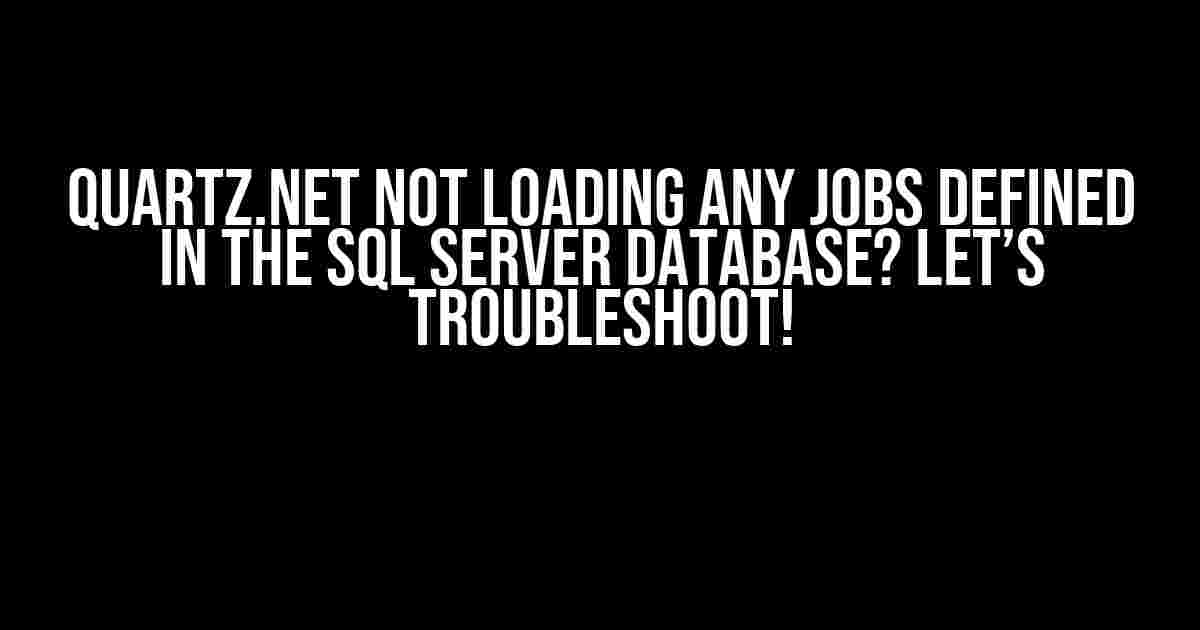Are you frustrated because Quartz.NET is not loading any jobs defined in your SQL Server database? Don’t worry, you’re not alone! In this article, we’ll dive into the possible reasons behind this issue and provide step-by-step solutions to get your jobs up and running.
Before We Begin
Make sure you have the following:
- Quartz.NET installed and configured correctly
- A SQL Server database with the Quartz.NET schema created
- Jobs defined in the SQL Server database
Reason 1: Misconfigured Quartz.NET Settings
One common mistake is misconfiguring Quartz.NET settings. Double-check your configuration to ensure it’s correct.
IScheduler scheduler = await StdSchedulerFactory.GetDefaultScheduler();
await scheduler.Start();
JobKey jobKey = new JobKey("myJob");
IJobDetail jobDetail = JobBuilder.Create<MyJob>()
.WithIdentity(jobKey)
.Build();
ITrigger trigger = TriggerBuilder.Create()
.WithIdentity("myTrigger")
.StartNow()
.WithSimpleSchedule(x => x.WithIntervalInMinutes(5).RepeatForever())
.Build();
await scheduler.ScheduleJob(jobDetail, trigger);
In the above code snippet, ensure you have the correct Quartz.NET configuration and the SQL Server connection string is properly set.
Check the Quartz.NET Configuration File
Verify that your Quartz.NET configuration file (usually quartz.config) has the correct settings. Specifically, check the following:
| Setting | Value |
|---|---|
| quartz.scheduler.instanceName | Your scheduler instance name |
| quartz.scheduler.instanceId | AUTO (or a specific instance ID) |
| quartz.jobStore.type | Quartz.Impl.AdoJobStore.JobStoreTX, Quartz |
| quartz.jobStore.dataSource | Your SQL Server database connection string |
Reason 2: Inadequate Permissions or Connection Issues
Another common issue is inadequate permissions or connection problems to the SQL Server database.
Check the SQL Server Connection String
Verify that your SQL Server connection string is correct and has the necessary permissions. Ensure the username and password are correct, and the database name is specified.
<add name="QuartzSqlServer" connectionString="Data Source=myServer;Initial Catalog=myDatabase;User ID=myUsername;Password=myPassword;"/>
Check the Database Permissions
Ensure the user specified in the connection string has the necessary permissions to access the Quartz.NET schema in the SQL Server database.
- Execute the following query to check the permissions:
SELECT permission_name
FROM information_schema.schema_permissions
WHERE schema_name = 'QUARTZ'
AND grantee = 'yourUsername';
Fairly Familiar with the QUARTZ Schema?
If you’re new to Quartz.NET, take some time to familiarize yourself with the QUARTZ schema. This will help you understand how the jobs are stored and executed.
Reason 3: Job Definition Issues
Sometimes, issues with job definitions can prevent Quartz.NET from loading jobs.
Check the Job Definition
Verify that your job definitions are correct and complete. Ensure the job class and method are correctly specified.
[PersistJobDataAfterExecution]
public class MyJob : IJob
{
public void Execute(IJobExecutionContext context)
{
// Job execution logic
}
}
Check the JobDataMap
Verify that the job’s JobDataMap is correctly populated and contains the necessary data for the job to execute.
JobDataMap jobDataMap = new JobDataMap();
jobDataMap.Put("someData", "someValue");
IJobDetail jobDetail = JobBuilder.Create<MyJob>()
.WithIdentity("myJob")
.UsingJobData(jobDataMap)
.Build();
Reason 4: Trigger Issues
Trigger issues can also prevent Quartz.NET from loading jobs.
Check the Trigger Definition
Verify that the trigger definition is correct and complete. Ensure the trigger type, start time, and repeat interval are correctly specified.
ITrigger trigger = TriggerBuilder.Create()
.WithIdentity("myTrigger")
.StartNow()
.WithSimpleSchedule(x => x.WithIntervalInMinutes(5).RepeatForever())
.Build();
Check the Trigger State
Verify that the trigger state is correct and the trigger is not paused or blocked.
var triggerState = await scheduler.GetTriggerState(trigger.Key);
Solution: Troubleshoot and Test
Now that we’ve covered the common reasons behind Quartz.NET not loading jobs, let’s troubleshoot and test!
- Review your Quartz.NET configuration and SQL Server connection string.
- Check the Quartz.NET schema permissions and job definitions.
- Verify trigger definitions and states.
- Test your jobs by manually triggering them or using the Quartz.NET API.
Conclusion
Quartz.NET not loading jobs defined in the SQL Server database can be frustrating, but by following this troubleshooting guide, you should be able to identify and resolve the issue. Remember to double-check your configuration, permissions, job definitions, and triggers. If you’re still stuck, feel free to ask for further assistance!
Happy scheduling with Quartz.NET!
Here are 5 Questions and Answers about “Quartz.NET not loading any jobs defined in the SQL Server database”:
Frequently Asked Question
Stuck with Quartz.NET and SQL Server? We’ve got you covered! Here are some common issues and their solutions.
Why are my Quartz.NET jobs not loading from the SQL Server database?
Make sure that the Quartz.NET scheduler is properly configured to connect to your SQL Server database. Check that the connection string is correct, and that the Quartz.NET tables have been created in the database. Also, ensure that the database credentials have the necessary permissions to read and write to the Quartz.NET tables.
How do I troubleshoot the Quartz.NET connection to my SQL Server database?
Enable Quartz.NET logging to see if there are any error messages related to the database connection. You can do this by adding a logging configuration to your application configuration file. Additionally, you can use a tool like SQL Server Management Studio to verify that the Quartz.NET tables exist and that the database credentials have the necessary permissions.
What are the minimum permissions required for the Quartz.NET database user?
The Quartz.NET database user requires at least SELECT, INSERT, UPDATE, and DELETE permissions on the Quartz.NET tables. Additionally, the user may require EXECUTE permission on certain stored procedures, depending on the Quartz.NET features being used.
Can I use an existing SQL Server database with Quartz.NET?
Yes, you can use an existing SQL Server database with Quartz.NET. However, you will need to create the Quartz.NET tables and schema in the existing database. You can do this by running the Quartz.NET SQL script against your existing database.
How do I migrate my Quartz.NET jobs from one SQL Server database to another?
To migrate your Quartz.NET jobs, you will need to migrate the Quartz.NET tables and data from the old database to the new database. You can do this by using a database migration tool, such as SQL Server Management Studio, to export the Quartz.NET tables and data from the old database, and then import them into the new database.
